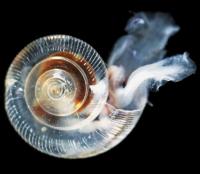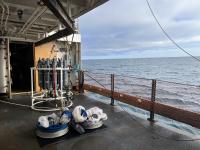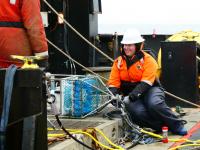Ocean Biomolecular Time Series
As a global leader in science, NOAA collects large quantities of physical and chemical oceanographic data. The NOAA PMEL Ocean Molecular Ecology program leverages these ocean observing platforms to better understand the impacts of climate change on marine ecosystems using 'Omics technologies. The impacts of ocean acidification and climate change can be observed on marine life through observations of changes in stress, population distribution, and abundance. By scaling biological observations alongside physical and chemical processes we can close the loop on characterizing marine ecosystem responses to changing ocean conditions. This allows us to better understand how U.S. West Coast and Arctic and Alaska ecosystems are changing in response to increases in warming, ocean acidification, and hypoxia (WOAH) and other human-driven impacts. Critically, these data will enable us to generate ecosystem health indicators for warming, ocean acidification, and hypoxia stressors that can be used by federal, state, and local managers to evaluate ecosystem status and trends.
We strive to achieve our objectives through our two science pillars:
- Establishing long-term biomolecular observations of marine biodiversity to track changes in marine ecosystem structure & function
- Characterizing and measuring stress responses from climate change and anthropogenic threats in key taxa.
Collectively, these efforts will be used to develop eDNA-based ecosystem health indices relevant to NOAA Fisheries Integrated Ecosystem Assessments, the Ocean Acidification Program, and the Status of the California Current and Alaska marine regions.
Using ‘omics to monitor fast-changing West Coast marine ecosystems
The U.S. West Coast has experienced rapid changes in ocean conditions in the past century driven by climate change and coastal eutrophication, making it an epicenter for exposure to ocean warming, acidification, and hypoxia. Understanding these impacts on coastal ecosystems is critical for effective management and stewardship of marine resources.
To enhance our ability to detect and track the impacts of ocean stressors on species of ecological and economic importance we are leveraging eDNA and 'Omics approaches to scale ocean biodiversity observations of microbes, phytoplankton, zooplankton, and fishes. Specifically, we maintain seawater eDNA time series from the West Coast Ocean Acidification (since 2021) to capture ocean basin scale changes in species- and community-level abundance and spatial distributions alongside high-resolution carbonate chemistry measurements. In addition, we have paired autonomous eDNA samplers with oxygen and temperature mooring sensors in Olympic Coast National Marine Sanctuary to track how marine species are responding to strong coastal acidification and hypoxia.
Key to the success of this project is developing novel eDNA tools for WOAH priority species assays and quantitative metabarcoding including krill (Euphausia pacifica), Dungeness crab (Metacarcinus magister), pteropods (Limacina helicina), and sunflower stars (Pycnopodia helianthoides). This project aims to develop quantitative metabarcoding approaches to characterize marine communities across gradients of warming, ocean acidification, and hypoxia. Importantly, synthesizing our co-located oceanographic and eDNA time series with partner NOAA, state, academic, and regional eDNA datasets will enable an unprecedented scale of biodiversity observations across space and time.
Using 'omics to monitor the effects of rapidly changing oceans on Alaska and Arctic marine ecosystems
Alaska and Arctic Marine Ecosystems are rapidly changing in response to climate change in the past century with accelerating ocean warming and sea ice loss leading to cascading ecosystem effects. As along the West Coast, in the Arctic and Alaska we are leveraging eDNA approaches to scale ocean biodiversity observations co-located with physical and chemical measurements. Specifically, we maintain seawater eDNA time series from Ecosystem and Fisheries Oceanography Coordinated Investigations (EcoFOCI) and partner cruises (since 2020).
Monitoring in the Arctic is challenging given its remoteness and the difficulty of navigating harsh sea ice and ocean conditions, making it impossible to study biodiversity for half the year. To address this key missing observation gap we are deploying autonomous eDNA samplers under the sea ice to enhance our ability to detect and track species of ecological and economic importance during winter months. This work will enhance NOAA's ability to characterize marine communities across the Eastern and Northern Bering Sea and the U.S. Arctic and fill critical data gaps on marine microbes, phytoplankton, zooplankton, and fish species.

Pteropods are among the many species directly impacted by ocean acidification. Credit: NOAA Fisheries

Zooplankton net tow samples collected on the 2021 West Coast Ocean Acidification Cruise. Credit: Zack Gold/NOAA

Owen Yazzie, an undergraduate intern, processing eDNA samples on the Olympic Coast National Marine Sanctuary's vessel. Credit: Shannon Brown/NOAA




